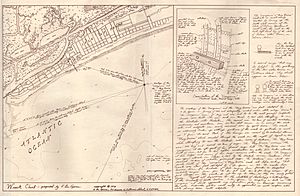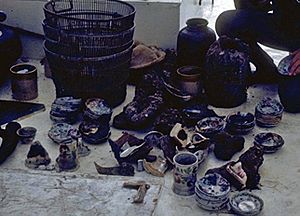SS Georgiana facts for kids
Quick facts for kids History |
|
|---|---|
| Name | Georgiana |
| Builder | Lawrie Shipyard (subcontract with Laird?) |
| Laid down | 1862 |
| Launched | 1863 |
| Commissioned | n/a |
| Fate | Scuttled and burned to avoid capture, 19 March 1863 |
| Status | Shipwreck located by E. Lee Spence at 32°46′47″N 79°45′35″W / 32.77972°N 79.75972°W |
| Notes | Sunk on maiden voyage before her guns were mounted, described as designed to become the "most powerful" Confederate cruiser. |
| General characteristics | |
| Class and type | Reportedly built to serve as a cruiser or a privateer |
| Tonnage |
|
| Length | 205 ft 6 in (62.64 m) |
| Beam | 25 ft 2 in (7.67 m) |
| Draft | 14 ft 0 in (4.27 m) forward, 15 ft 0 in (4.57 m) aft also reported as 1 foot 6 inches (0.46 m) |
| Depth of hold | 14 feet 9 inches (4.50 m) |
| Propulsion | steam screw, variously reported 120 to 250 horsepower (89 to 186 kW), and capable of 12 to 17 knots (22 to 31 km/h) |
| Sail plan | brig |
| Complement | reported as 140 men |
| Armament | reported as 2 heavy guns mounted on deck and "pierced for either fourteen or twenty guns" |
| Notes | iron hull, 3 bulkheads, figurehead of a demi-woman |
The Georgiana was a special kind of ship called a brig-rigged, iron-hulled, propeller steamer. This means she had two masts with square sails (like a brig), was made of iron, and used a propeller powered by steam to move. She belonged to the Confederate States Navy during the American Civil War. People thought she would become the "most powerful" warship for the Confederates once her guns were put on. However, she never got to fight in a battle.
On her very first trip from Scotland, where she was built, she ran into Union Navy ships. These ships were trying to blockade (block off) the port of Charleston, South Carolina. The Georgiana was badly damaged. To stop her from being captured, her captain made her sink on purpose, which is called scuttling. This happened on March 19, 1863. The sunken ship was found in 1965 and still lies in the shallow waters of Charleston's harbor today. Because her building and first trip were kept secret, people have wondered if she was meant to be a warship, a trading ship, or a privateer (a private ship allowed to attack enemy ships).
Contents
The Georgiana's Design and Features
The Georgiana was a brig-rigged, iron-hulled steamship. She had a powerful engine of 120 horsepower and could carry over 400 tons of cargo. Her front, called a clipper bow, had a "demi-woman" figurehead (a carved figure). She was built in Glasgow, Scotland, in 1862 by the Lawrie shipyard.
The ship was designed to hold many guns. Some reports said she could have 14 guns, and others suggested even more. The U.S. Consul (a government official) in Tenerife thought she looked like a very fast ship. Captain Thomas Turner of the Union Navy believed the Georgiana was sent to Charleston to get her officers and guns, becoming a warship there. He reported that she had 140 men and guns in her cargo hold, led by a retired British naval officer.
The Loss of the Georgiana
The Georgiana was lost on the night of March 19, 1863. She was trying to sneak past the Union ships blocking Charleston, South Carolina. The armed U.S. Yacht America, famous from the America's Cup race, spotted her. The America sent up signal flares to alert the other Union ships.
The Georgiana was chased by the Union fleet. She got so close to the big guns of the USS Wissahickon that her crew could hear the orders being shouted on the Union ship. The Georgiana was hit by cannonballs that went right through her hull. Her propeller and steering rudder were damaged, and there was no way to escape.
Captain A. B. Davidson of the Georgiana showed a white light, which meant he was surrendering. This gave him time to steer his ship onto the beach in shallow water, about three-quarters of a mile from shore. After making sure the ship would sink, he and his entire crew escaped to land. The Union sailors were very disappointed because they would have gotten money if they had captured the ship.
Lieutenant Commander John L. Davis, who was in charge of the Wissahickon, decided to set the wreck on fire. He wanted to make sure that no one from shore could try to save the ship or its valuable cargo. The Georgiana burned for several days, with big explosions from gunpowder on board.
The Georgiana and her cargo were owned by George Alfred Trenholm. He was a very rich banker and shipper from Charleston. He also served as the Treasurer for the Confederacy. He is thought to be the real-life person who inspired the character Rhett Butler in the famous book Gone With The Wind.
Discovery of the Wreck
The wreck of the Georgiana was found by an underwater archaeologist named E. Lee Spence in 1965. Today, the Georgiana rests on the ocean floor. Her large boiler is only about five feet (1.5 meters) below the surface. The wreck is now covered with many sea creatures like sea fans, sea whips, and living corals.
Many parts of the ship's hull are still in good condition. In some places, the right side of the hull sticks out over nine feet (3 meters) from the sand. The ship's deck, which was made of white pine, has long since been eaten away by sea life. You can find sea urchins and sea anemones all over the wreck. Many fish also visit the wreck, including sea bass, grouper, flounder, stingrays, seahorses, and toadfish.
Near the front cargo area, Spence found boxes of pins and buttons. He also recovered other items like medicines and supplies. These items were worth a lot of money, over $12,000,000! However, he never found the 350 pounds (160 kg) of gold that people believed was hidden on the ship. This gold could be worth more than $15,000,000 to coin collectors. If you add up all the possible cargo, the Georgiana's total value could be $50,000,000.
On top of the broken remains of the Georgiana lies another ship. This is the sidewheel steamer Mary Bowers. The Mary Bowers hit the wreck of the Georgiana while also trying to sneak into Charleston during the blockade.
The Wreck Site: A Historical Treasure
This wreck site is very important for history and archaeology. It's important historically because both sides of the war (the Confederates and the Federals) thought the Georgiana was a big threat to Union shipping.
It's also important for archaeology because the site has two different types of ships. Both ships were made of iron. However, the Georgiana was built very strong with a deep bottom, good for a warship on the open ocean. The Mary Bowers was built very light with a shallow bottom, perfect for running the blockade by crossing shallow areas where bigger Union ships couldn't go. One ship (the Georgiana) used a propeller, and the other (the Mary Bowers) used sidewheels. These two ships were built and lost only about two years apart, which makes their design differences even more interesting.
The Georgiana/Mary Bowers wreck site was where the very first license to salvage (recover items from a wreck) was given in South Carolina in 1967. Hundreds of thousands of items have been found at this site. State officials first explored the site by diving in 2010.
Was the Georgiana a Warship or a Merchant Ship?
Because of all the secrecy around her building, loading, and first trip, there's a lot of debate about what the Georgiana was truly meant to be. Was she just a regular merchantman (a ship for trading goods)? Or was she planned as a privateer or a blockade runner (a ship designed to sneak past blockades)?
One report from that time said the Georgiana was built so lightly that "she would shake from stem to stern if a gun were fired from her decks." Historian Stephen Wise believes she was a merchant ship. He wrote that the Union consul, Thomas Dudley, checked the ship in Liverpool and thought she was too weak to be a warship. He felt her only purpose was to run the blockade.
However, a U.S. government message from January 6, 1863, said: "The steamer Georgiana, just arrived at Liverpool from the Clyde. She is new and said to be a very superior steamer. ··· Yesterday while lying here she had the Rebel flag flying at her mast." The London American newspaper wrote on January 28, 1863, that she was a powerful steamer. It also noted that her officers wore gold lace on their caps, which was usually a sign that a ship was being prepared for war.
After the Georgiana was lost on March 19, 1863, the United States Secretary of Navy wrote: "the destruction of the Georgiana not only touched their (the Confederate's) pockets, but their hopes. She was a splendid craft, peculiarly fitted for the business of privateering." The New York Times on March 31, 1863, shared a spy's description of the ship as "a superior vessel, ··· built expressly for the rebel navy." The spy said she was "altogether a faster, stauncher, and better vessel than either the Oreto (Florida) or Alabama."
The London Times on April 8, 1863, described her: "There is not the least doubt of her being intended as a privateer." Thomas Scharf, who served in the Confederate navy, wrote in his book History of the Confederate Navy that her loss was a big blow to the Confederacy. He said she was "a much faster and stronger ship than any one of its cruisers afloat and would have made a superb man-of-war."
Underwater archaeologist E. Lee Spence, who found the wreck, believes the Georgiana was indeed meant to be a privateer or a cruiser (a type of warship). He bases this on the naval guns found on board, her deep hull design, her thicker-than-normal iron plating, and the extra strong, closely spaced framing used throughout the ship.
Images for kids





